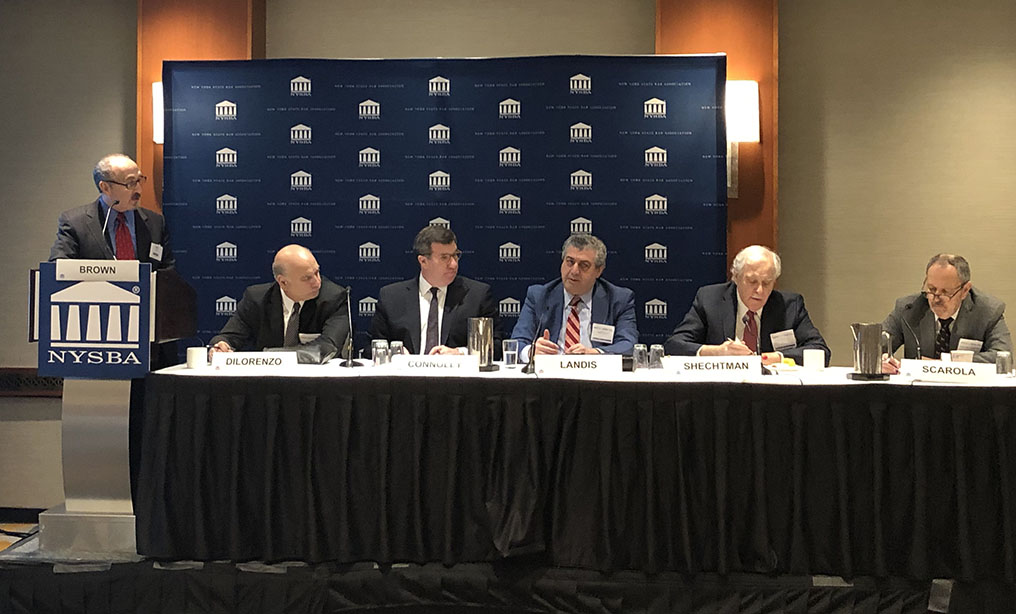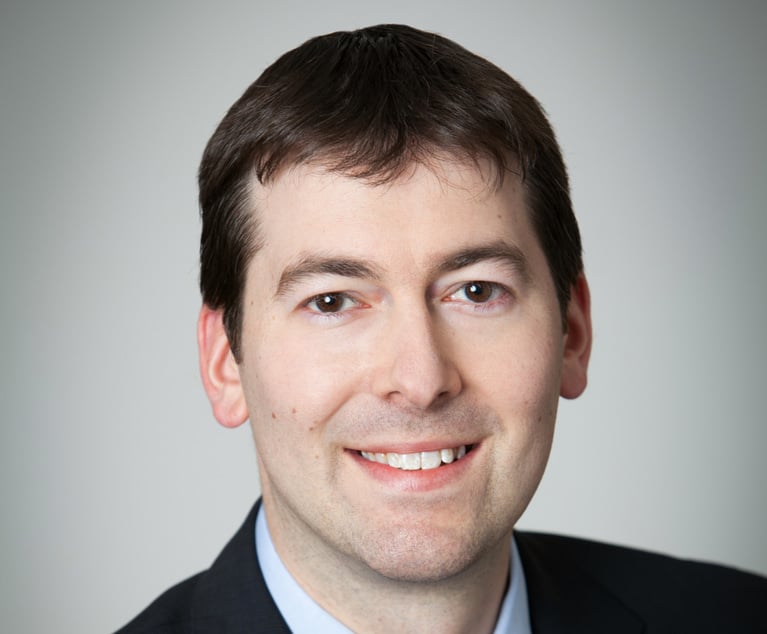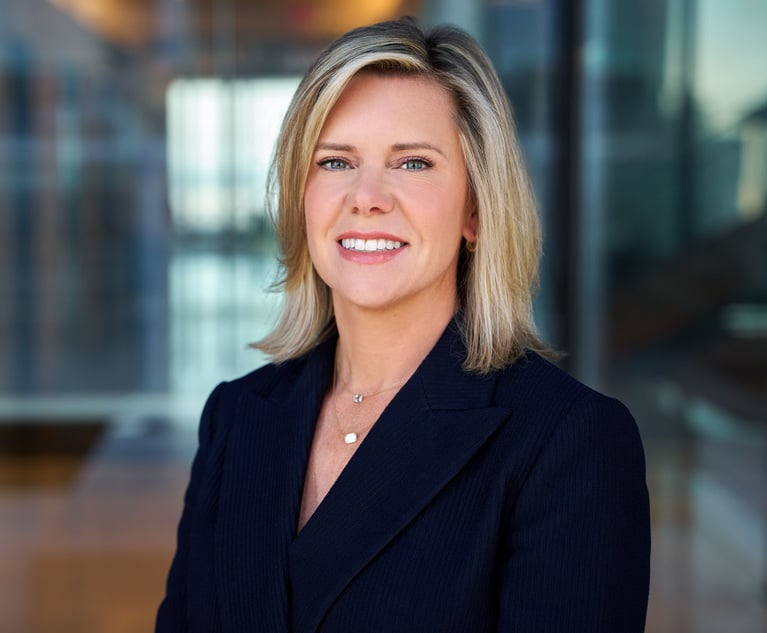From Succession Planning to Office Space, Law Firm Leaders Discuss Industry Concerns
Managing partners at several New York law offices spoke about some of the most pressing concerns facing firms.
January 30, 2020 at 06:12 PM
4 minute read
 Managing Partners Roundtable, part of the Law Practice Management Day on Jan. 30 at the NYSBA's annual meeting. From left: moderator Craig Brown of Cadence Counsel, Louis DiLorenzo of Bond, Schoeneck & King, Daniel Connolly of Bracewell, Marc Landis of Phillips Nizer, Ronald Shechtman of Pryor Cashman, Richard Scarola of Scarola Zubatov Schaffzin. Courtesy of the NYSBA
Managing Partners Roundtable, part of the Law Practice Management Day on Jan. 30 at the NYSBA's annual meeting. From left: moderator Craig Brown of Cadence Counsel, Louis DiLorenzo of Bond, Schoeneck & King, Daniel Connolly of Bracewell, Marc Landis of Phillips Nizer, Ronald Shechtman of Pryor Cashman, Richard Scarola of Scarola Zubatov Schaffzin. Courtesy of the NYSBA
What are some of the most pressing issues for law firm leaders these days?
Several managing partners from large to small firms discussed Thursday a host of challenges in the legal industry, such as millennial demands, succession planning, real estate costs and how to handle lawyers who don't generate enough business.
The firm leaders included Daniel Connolly, who leads Bracewell's Manhattan office; Louis DiLorenzo, the managing member in New York City for Bond, Schoeneck & King; Ronald Shechtman, of Pryor Cashman; Marc Landis, of the roughly 70-lawyer firm Phillips Nizer; and Richard Scarola, of 12-lawyer Scarola Zubatov Schaffzin. They shared their opinions and experiences at a panel of the New York State Bar Association's annual meeting.
Some of them described their main priorities as keeping business going when younger lawyers have such different expectations from older ones.
At Bracewell, Connolly said the firm has a "mandatory but discretionary" retirement age. Older partners want credit for the clients they've brought to a law firm, he said, and at Bracewell, they have to write up a plan for how to hand off business to younger attorneys who they've practiced with over the years.
Younger lawyers value things like sabbaticals and family time more than their predecessors, Connolly said, but they're not totally above creature comforts. He described visiting one firm that didn't assign its youngest associates to specific offices—which one younger lawyer confided he didn't like at all, Connolly said.
At Pryor Cashman, Shechtman said, collaboration is key. He was one of several panelists to discourage working from home, saying that coming into the office built bonds among lawyers. Pryor Cashman's low leverage—its partner to nonpartner ratio is about 1:1, he added—was among the factors that made satisfied associates stick around.
"The greatest management challenge for our firm is to maintain the culture that we have," Shechtman said.
The Pryor Cashman leader expressed satisfaction with business development patterns at the firm, saying, "40% of our partners originate $1 million or more. Two-thirds of our partners originate $500,000 or more."
DiLorenzo, of Bond Schoeneck, noted not every lawyer is going to be a business generator. He described how promising midlevel associates at Bond Schoeneck are identified early. Other lawyers, he said, are given the message that if they're not going to develop clients, they need to prove their value to the firm in other ways, like by writing newsletters.
"Watching television at home is not going to bring us anything," he said. "We all have to participate in this, or people don't survive."
For smaller firms, real estate costs are a large concern. Scarola spoke on the huge expense of a lease for small firms like his and the need to sublet space to other lawyers.
Landis pointed out the managing partner panel wasn't diverse—and said the next generation of law firm leadership would be.
"You're looking at five white men, and that is not what law firms look like anymore," he said, adding leaders need to ensure that women, non-white or otherwise diverse lawyers need to be given opportunities to learn the business of law.
This content has been archived. It is available through our partners, LexisNexis® and Bloomberg Law.
To view this content, please continue to their sites.
Not a Lexis Subscriber?
Subscribe Now
Not a Bloomberg Law Subscriber?
Subscribe Now
NOT FOR REPRINT
© 2025 ALM Global, LLC, All Rights Reserved. Request academic re-use from www.copyright.com. All other uses, submit a request to [email protected]. For more information visit Asset & Logo Licensing.
You Might Like
View All
Orrick Hires Longtime Weil Partner as New Head of Antitrust Litigation

Profits Surge Across Big Law Tiers, but Am Law 50 Segmentation Accelerates
4 minute readLaw Firms Mentioned
Trending Stories
- 1Consumer Protection Suit Cleared to Go Forward Against Irritating Eye Serum
- 2COVID-19 Was Still Relevant in Securities Class Actions During 2024, Report Says
- 3After Botched Landing of United Airlines Boeing 767, Unlikely Plaintiff Sues Carrier
- 4DOT Moves to Roll Back Emissions Rules, Eliminate DEI Programs
- 5No Injury: Despite Proven Claims, Antitrust Suit Fails
Who Got The Work
J. Brugh Lower of Gibbons has entered an appearance for industrial equipment supplier Devco Corporation in a pending trademark infringement lawsuit. The suit, accusing the defendant of selling knock-off Graco products, was filed Dec. 18 in New Jersey District Court by Rivkin Radler on behalf of Graco Inc. and Graco Minnesota. The case, assigned to U.S. District Judge Zahid N. Quraishi, is 3:24-cv-11294, Graco Inc. et al v. Devco Corporation.
Who Got The Work
Rebecca Maller-Stein and Kent A. Yalowitz of Arnold & Porter Kaye Scholer have entered their appearances for Hanaco Venture Capital and its executives, Lior Prosor and David Frankel, in a pending securities lawsuit. The action, filed on Dec. 24 in New York Southern District Court by Zell, Aron & Co. on behalf of Goldeneye Advisors, accuses the defendants of negligently and fraudulently managing the plaintiff's $1 million investment. The case, assigned to U.S. District Judge Vernon S. Broderick, is 1:24-cv-09918, Goldeneye Advisors, LLC v. Hanaco Venture Capital, Ltd. et al.
Who Got The Work
Attorneys from A&O Shearman has stepped in as defense counsel for Toronto-Dominion Bank and other defendants in a pending securities class action. The suit, filed Dec. 11 in New York Southern District Court by Bleichmar Fonti & Auld, accuses the defendants of concealing the bank's 'pervasive' deficiencies in regards to its compliance with the Bank Secrecy Act and the quality of its anti-money laundering controls. The case, assigned to U.S. District Judge Arun Subramanian, is 1:24-cv-09445, Gonzalez v. The Toronto-Dominion Bank et al.
Who Got The Work
Crown Castle International, a Pennsylvania company providing shared communications infrastructure, has turned to Luke D. Wolf of Gordon Rees Scully Mansukhani to fend off a pending breach-of-contract lawsuit. The court action, filed Nov. 25 in Michigan Eastern District Court by Hooper Hathaway PC on behalf of The Town Residences LLC, accuses Crown Castle of failing to transfer approximately $30,000 in utility payments from T-Mobile in breach of a roof-top lease and assignment agreement. The case, assigned to U.S. District Judge Susan K. Declercq, is 2:24-cv-13131, The Town Residences LLC v. T-Mobile US, Inc. et al.
Who Got The Work
Wilfred P. Coronato and Daniel M. Schwartz of McCarter & English have stepped in as defense counsel to Electrolux Home Products Inc. in a pending product liability lawsuit. The court action, filed Nov. 26 in New York Eastern District Court by Poulos Lopiccolo PC and Nagel Rice LLP on behalf of David Stern, alleges that the defendant's refrigerators’ drawers and shelving repeatedly break and fall apart within months after purchase. The case, assigned to U.S. District Judge Joan M. Azrack, is 2:24-cv-08204, Stern v. Electrolux Home Products, Inc.
Featured Firms
Law Offices of Gary Martin Hays & Associates, P.C.
(470) 294-1674
Law Offices of Mark E. Salomone
(857) 444-6468
Smith & Hassler
(713) 739-1250








